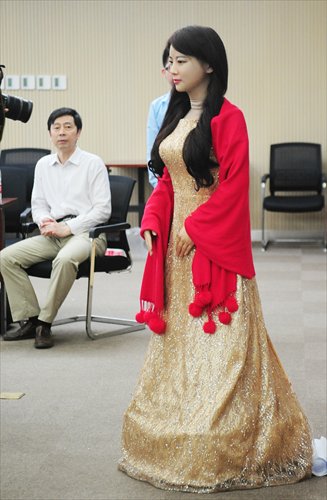by ZHANG YU
 Jiajia looks lifelike wearing a dress and a shawl. Sitting on the left is its creator professor Chen Xiaoping PHOTO/CFP
Jiajia looks lifelike wearing a dress and a shawl. Sitting on the left is its creator professor Chen Xiaoping PHOTO/CFP
With her fair skin, rosy cheeks and wide eyes, you can easily mistake Jiajia for a beautiful woman. But once she starts to speak, you’d realize that she’s a humanoid robot.
Jiajia, the fembot that was unveiled this month at the University of Science and Technology of China (USTC) in Hefei, Anhui Province, impressed crowds with her human features. Jiajia can speak, move her lips, respond to questions and show a limited number of expressions.
Jiajia is the brainchild of 61-year-old Chen Xiaoping, professor at the university’s computer science department, and his colleagues. The Global Times talked to him about his experience in the field of artificial intelligence (AI) and the story behind Jiajia.
Following footsteps
While the field of AI research started in the US in the 1950s, it took off much later in China. Until the early 1990s, it was an idea that was so ahead of time that it was rather neglected. Most Chinese computer scientists focused on either computation theory, a field in which it was easier to make academic achievements, or software coding, which had more practical and commercial value.
Chen had initially focused on computation theory. But he chose to shift to AI.
“I was really interested in it, and I had this belief that it would one day become meaningful,” he said.
The Internet was a new thing in the 1990s, and access to new ideas and information was much more limited than today. To follow the latest academic progress on AI, Chen visited Beijing for several months every year, spending most of his time in the then Beijing Library and the library of the Chinese Academy of Sciences, where the latest papers about science and technology could be found. But even these papers were far from up-to-date and many were written one to two years prior.
Just like most Chinese scientists back then, Chen said he initially focused on the specific theoretical problems that Western scientists couldn’t work out. This proved fruitful, at least academically. In 1999, during the International Joint Conference on Artificial Intelligence, the main international gathering of AI researchers, Chen’s paper “A logic of intention” was the only paper by a Chinese scientist that was presented and published in the proceedings of the conference.
While he started to gain international recognition, Chen felt focusing on these theoretical issues wasn’t the path to technological advancements.
Global Times for more
